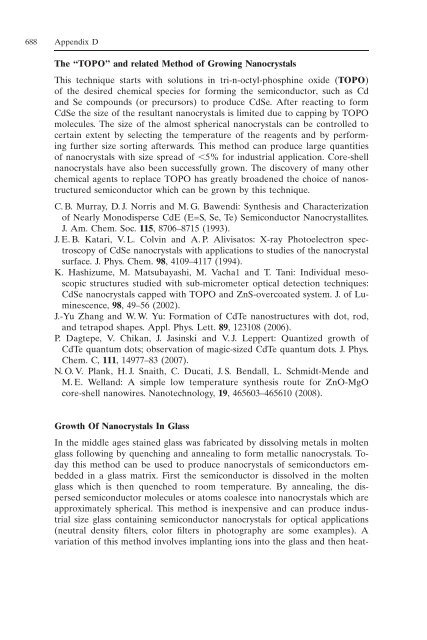10. Appendix
Create successful ePaper yourself
Turn your PDF publications into a flip-book with our unique Google optimized e-Paper software.
688 <strong>Appendix</strong> D<br />
The “TOPO” and related Method of Growing Nanocrystals<br />
This technique starts with solutions in tri-n-octyl-phosphine oxide (TOPO)<br />
of the desired chemical species for forming the semiconductor, such as Cd<br />
and Se compounds (or precursors) to produce CdSe. After reacting to form<br />
CdSe the size of the resultant nanocrystals is limited due to capping by TOPO<br />
molecules. The size of the almost spherical nanocrystals can be controlled to<br />
certain extent by selecting the temperature of the reagents and by performing<br />
further size sorting afterwards. This method can produce large quantities<br />
of nanocrystals with size spread of 5% for industrial application. Core-shell<br />
nanocrystals have also been successfully grown. The discovery of many other<br />
chemical agents to replace TOPO has greatly broadened the choice of nanostructured<br />
semiconductor which can be grown by this technique.<br />
C. B. Murray, D. J. Norris and M. G. Bawendi: Synthesis and Characterization<br />
of Nearly Monodisperse CdE (E=S, Se, Te) Semiconductor Nanocrystallites.<br />
J. Am. Chem. Soc. 115, 8706–8715 (1993).<br />
J. E. B. Katari, V. L. Colvin and A. P. Alivisatos: X-ray Photoelectron spectroscopy<br />
of CdSe nanocrystals with applications to studies of the nanocrystal<br />
surface. J. Phys. Chem. 98, 4109–4117 (1994).<br />
K. Hashizume, M. Matsubayashi, M. Vacha1 and T. Tani: Individual mesoscopic<br />
structures studied with sub-micrometer optical detection techniques:<br />
CdSe nanocrystals capped with TOPO and ZnS-overcoated system. J. of Luminescence,<br />
98, 49–56 (2002).<br />
J.-Yu Zhang and W. W. Yu: Formation of CdTe nanostructures with dot, rod,<br />
and tetrapod shapes. Appl. Phys. Lett. 89, 123108 (2006).<br />
P. Dagtepe, V. Chikan, J. Jasinski and V. J. Leppert: Quantized growth of<br />
CdTe quantum dots; observation of magic-sized CdTe quantum dots. J. Phys.<br />
Chem. C, 111, 14977–83 (2007).<br />
N. O. V. Plank, H. J. Snaith, C. Ducati, J. S. Bendall, L. Schmidt-Mende and<br />
M. E. Welland: A simple low temperature synthesis route for ZnO-MgO<br />
core-shell nanowires. Nanotechnology, 19, 465603–465610 (2008).<br />
Growth Of Nanocrystals In Glass<br />
In the middle ages stained glass was fabricated by dissolving metals in molten<br />
glass following by quenching and annealing to form metallic nanocrystals. Today<br />
this method can be used to produce nanocrystals of semiconductors embedded<br />
in a glass matrix. First the semiconductor is dissolved in the molten<br />
glass which is then quenched to room temperature. By annealing, the dispersed<br />
semiconductor molecules or atoms coalesce into nanocrystals which are<br />
approximately spherical. This method is inexpensive and can produce industrial<br />
size glass containing semiconductor nanocrystals for optical applications<br />
(neutral density filters, color filters in photography are some examples). A<br />
variation of this method involves implanting ions into the glass and then heat-










